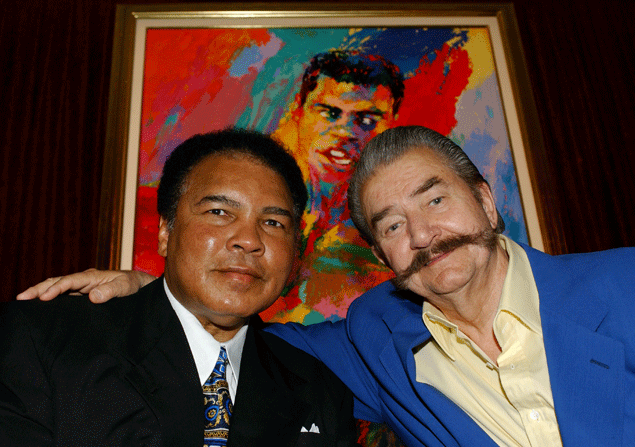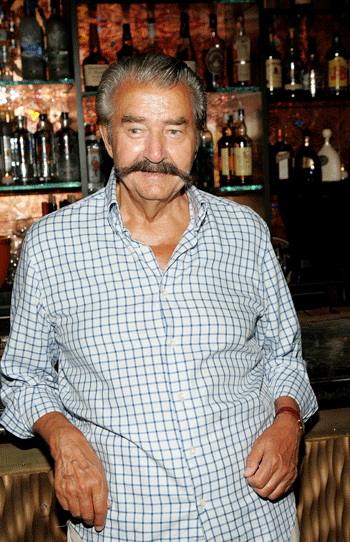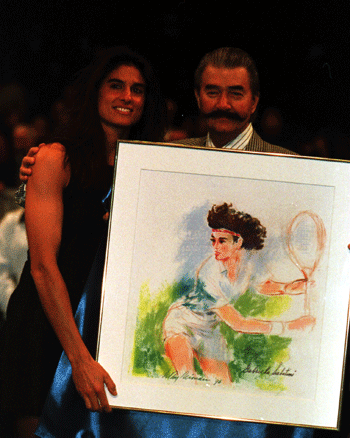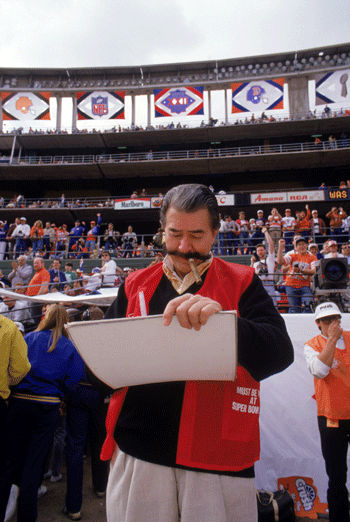LeRoy Neiman: 1921-2012


LeRoy Neiman, who died on Wednesday, had a front-row seat on the sports scene for more than fifty years. His first brush with fame came in 1953, when he was designated as the official artist for a fledgling magazine called Playboy. As the decades passed, he became an American institution.
Ten years ago, I wrote about LeRoy from an unusual perspective. I’d written a novel that was about to be published, and he drew my likeness for the dust jacket.
LeRoy was a nice man. The boxing scene was more fun because he was part of it.
*
A Sports Fan is Painted by LeRoy Neiman
Actually, it isn’t a painting. He used pastels.
But it’s more than a sketch. “A study,” he called it.
And with a simple act of kindness, LeRoy Neiman added to the good deeds he has performed over a lifetime.
Neiman was born in Minnesota on June 8, 1921. His father (Charles Runquist) was an unskilled laborer, who abandoned the family when LeRoy was young. His mother remarried twice, and LeRoy took the surname of one of his stepfathers.
As a child, Neiman was drawn to art. In grade school, he put pen-and-ink tattoos on the arms of fellow students. In high school, although lacking in formal training, he created posters for athletic events and earned pocket cash by painting images of meat, fruit, and vegetables on grocery store windows. Later, as a mess sergeant in the army during World War II, he designed posters, painted sexually suggestive murals in mess halls, and otherwise served the Allied cause.
After the war, Neiman studied at the St. Paul Art Center and the Art Institute of Chicago. Then he began work as a fashion illustrator and, while freelancing in Chicago, met a young copywriter named Hugh Hefner.
In 1953, Hefner launched Playboy, and Neiman became the magazine’s “official” artist. His first noteworthy  contribution was the creation of “Femlin” — a tiny character who has appeared on the Playboy jokes page in every issue since August 1955. Then, beginning in 1958 and continuing for the next fifteen years, Neiman traveled around the globe for Playboy to paint a monthly feature entitled “Man At His Leisure”. His artwork celebrated the privileged world of “beautiful people” and gave his audience an intimate look at the most elite places and events on the planet; all from a glorifying point of view.
contribution was the creation of “Femlin” — a tiny character who has appeared on the Playboy jokes page in every issue since August 1955. Then, beginning in 1958 and continuing for the next fifteen years, Neiman traveled around the globe for Playboy to paint a monthly feature entitled “Man At His Leisure”. His artwork celebrated the privileged world of “beautiful people” and gave his audience an intimate look at the most elite places and events on the planet; all from a glorifying point of view.
“When I paint,” LeRoy acknowledged, “I consider the public presence of a person; the surface facade. I’m less concerned with how people look when they wake up or how they act at home. A person’s public presence reflects his own efforts at image development. I focus on the beauty and the best. Sure, I’d rather paint a Rolls Royce than a Volkswagen.”
Meanwhile, Neiman was carefully cultivating his own image to make himself famous and wealthy. As Hugh Hefner later observed, “LeRoy quite intentionally invented himself as a flamboyant artist in much the same way that I became Mr. Playboy.” Neiman agrees, saying, “I guess I created LeRoy Neiman. Nobody else told me how to do it.”
Neiman was the first artist to successfully tap into the mass media. And over time, the Neiman style with its splashes of intense color and sense of motion became nationally known. In the late 1960s, he appeared regularly on New York Jets football telecasts as the team’s “official artist in residence.” At the 1972 Munich Olympics, he sketched live for ABC’s cameras. Four years later at the Montreal games, he painted a huge mural for a national television audience and entered into a deal with Burger King for the distribution of five Neiman posters in conjunction with an Olympics promotion. Purists groaned, but Leroy himself later said, “Those posters were distributed to kids who had never seen a painting before in their lives. And the Burger King project exposed my work to millions of people, so it was not a bad thing.”
In his most prolific years, Neiman created as many as a thousand pieces annually. “I work fast,” he said. “Sometimes I do forty sketches at one event. A painting generally takes me from two to three weeks.”
It’s a point of pride for LeRoy that no one but the artist himself has ever put a brush to one of his canvases. He has painted everything from nudes backstage at the Lido in Paris to the CD box for Frank Sinatra’s recording of “Duets”. However, he’s best known for his sports scenes and portraits of athletes.
“Concentrating on sports helped me,” Neiman admits. “There hasn’t been any sports art to speak of, so I’ve had the field pretty much to myself.” And he has made the most of that exclusivity, elevating himself to a special status in the world of sports.
When LeRoy Neiman paints an athlete or an event, it’s a stamp of importance. He has been the official artist for five Olympics and crafted images of countless Super Bowls, NBA playoffs, the World Series, the Grand Prix at Monaco, Oxford versus Cambridge on the Thames, horseracing, cricket, bullfights, tennis, golf, hockey, billiards, yachting, cycling; and of course, boxing.
Olympics and crafted images of countless Super Bowls, NBA playoffs, the World Series, the Grand Prix at Monaco, Oxford versus Cambridge on the Thames, horseracing, cricket, bullfights, tennis, golf, hockey, billiards, yachting, cycling; and of course, boxing.
It has been said in pugilistic circles that Neiman has a great right hand. Dozens of fight posters and program covers bear his work. At big fights, he has long been a flamboyant presence in a front row seat; his Salvador-Dali-like mustache every bit as distinctive as Don King’s hair.
“I had a mustache before I went into the army and they made me shave it off,” LeRoy recounts. “It was a Clark Gable mustache. Clark Gable was one of my heroes. They don’t have movie stars like that anymore. Anyway, after the war, I grew it back. Then, in the early 1960s, I had the same publisher as Salvador Dali. We spent some time together, and Dali’s wife told me, ‘Make up your mind; either cut it shorter or grow it out.’ So I let it grow. Sometimes I tell people it’s a virgin mustache, but that’s not true. It’s a prop, really. That’s all.”
Because of the mustache, LeRoy is easily recognizable in any setting. Stan Isaacs of Newsday once wrote, “Whether one approves of Neiman’s work or not, one must agree that he himself is a work of art.”
My own experience with LeRoy Neiman dates to 1989 when I interviewed him for a biography I was writing about Muhammad Ali. I arrived at his studio as per our appointment and was met with the question, “How do I know you’re for real?”
Apparently, someone had recently interviewed LeRoy for what turned out to be a non-existent project and walked out of his studio with several sketches. I produced a letter of authorization from Ali that I had brought with me for verification, and the interview began.
“I saw him in person for the first time in 1962,” LeRoy reminisced, thinking back on his introduction to Muhammad. “It was when he fought Billy Daniels at St. Nick’s Arena. I went back to this dingy dressing room, opened the door, and there was Ali — he was Cassius Clay then — sitting by himself on a table. I asked if I could draw him and he seemed to think that was a good idea, so I sat down and started to sketch. He was golden, no hair on his body, just beautiful. He looked like a piece of sculpture with no flaw or imperfection. His features and limbs were perfectly proportioned. He was an extraordinarily handsome charismatic man.”
Over time, Neiman became a fixture at Ali fights. On one occasion in the dressing room before a bout, Ali asked his trainer Angelo Dundee to turn off the lights because he wanted to see if LeRoy could sketch in the dark.
Meanwhile, after interviewing LeRoy, I saw him frequently at fights and occasional social functions. He was always pleasant and polite. Despite his status in the world of art, he carried himself in a way that made him seem approachable. Thus, on the night of January 15, 2000, when Roy Jones fought David Telesco at Radio City Music Hall, I approached him with a request.
The University of Arkansas Press was about to publish a novel I had written entitled Finding The Princess. University presses are notoriously lacking in funds to publicize their books. And a sketch of the author by LeRoy Neiman on the back of the dust jacket would . . . Well, you get the picture.
LeRoy told me to call him at his studio on Monday. A week later, I was sitting in front of the master.
“It bothers me that people don’t go to museums,” LeRoy said as he sketched. “Painters read books. Maybe you can tell me; why don’t more writers go to museums?”
Ten minutes after starting, he decided that he didn’t like the direction he was going in, put the first sheet of paper aside, and began anew . . . An orange pastel . . . Burnt umber . . . “Got to get the hair right,” he said. “And I want a serious look.”
Finding the Princesswas published later that year. I smile whenever I look at the dust jacket.
Meanwhile, like Old Man River, LeRoy Neiman keeps rolling along. He is, simply put, the most commercially  successful contemporary artist in America. His work is more popular now than ever. To his adoring followers, he can do no wrong. And his level of sustained activity is extraordinary.
successful contemporary artist in America. His work is more popular now than ever. To his adoring followers, he can do no wrong. And his level of sustained activity is extraordinary.
LeRoy’s artwork has appeared as etchings, sketches, lithographs, silkscreen prints, and paintings. Original Neiman paintings (acrylics, oil, or a mix) can be found for as little as $20,000 but most sell for multiples more. It costs in the neighborhood of $150,000 to commission a 24-by-36-inch Neiman portrait. The 18-by-30-inch “study” he did for me as a favor would run roughly $10,000.
Some favor.
For over a quarter-century, LeRoy has created limited-edition serigraphs (silkscreen prints) which are distributed by Knoedler Publishing. These serigraphs are printed in limited editions (usually 250 to 500 copies), then numbered and signed by the artist. In 1996, it was calculated that more than 150,000 LeRoy Neiman serigraphs had been purchased and that these prints had an estimated market value exceeding $400,000,000.
The numbers have gone higher since then.
In the late 1990s, Neiman created a six-by-four-foot “Athlete of the Century” painting of Muhammad Ali. One thousand limited-edition serigraphs were signed by Ali and the artist. Five hundred of the serigraphs had tiny additional drawings by LeRoy and Muhammad near the border and are now marketed at $8,000 each. The other five hundred are listed at $6,000. To date, over seven hundred “Athlete of the Century” serigraphs have been sold. Hammer Galleries, which handles much of Neiman’s output, values the original painting at $2,000,000.
In truth, there has been criticism of Neiman’s work. He has been called “the artist who critics love to hate” and “the most belittled artist of our time.” Art critic Hilton Kramer was once asked to share a few thoughts on LeRoy Neiman and answered, “That might be difficult. I never think of him.”
But the other side of the coin is that Neiman has brought art into more homes than any American artist ever. And it’s worth noting that the Smithsonian Institution happily accepted the donation of his archives to its own Archives of American Art. Thus, Neiman is able to say, “I get enough applause that I don’t mind the negative things that are said and written about me. Maybe the critics are right, but what am I supposed to do about it? Stop painting? Change my work completely? I go into the studio. There I am at the easel. I enjoy what I’m doing and feel good working. If anyone tarnished my reputation as a serious artist, it was myself by playing around with Playboy. But I learned a lot from those folks, and I don’t regret it.” Then he adds, “I’m doing the best work of my life right now. I’ve never said that before, but now it’s true. I’ve become more reflective.”
So there you have it. I’ve sat on the sofa in my living room next to Muhammad Ali, watching tapes of Ali-Liston, the Rumble in the Jungle, and the Thrilla in Manila. I’ve walked eighteen holes with Arnold Palmer and been interviewed by Howard Cosell. Now I’ve had my likeness drawn by LeRoy Neiman. What more could any sports fan want?
Maybe someday Michael Jordan will shoot hoops with me.
Photos / Denise Truscello, Paul Hawthorne, Al Bello, George Rose – Getty Images
Thomas Hauser can be reached by email at [email protected]. His newest book (And the New . . . : An Inside Look at Another Year in Boxing) will be published later this summer by the University of Arkansas Press.














